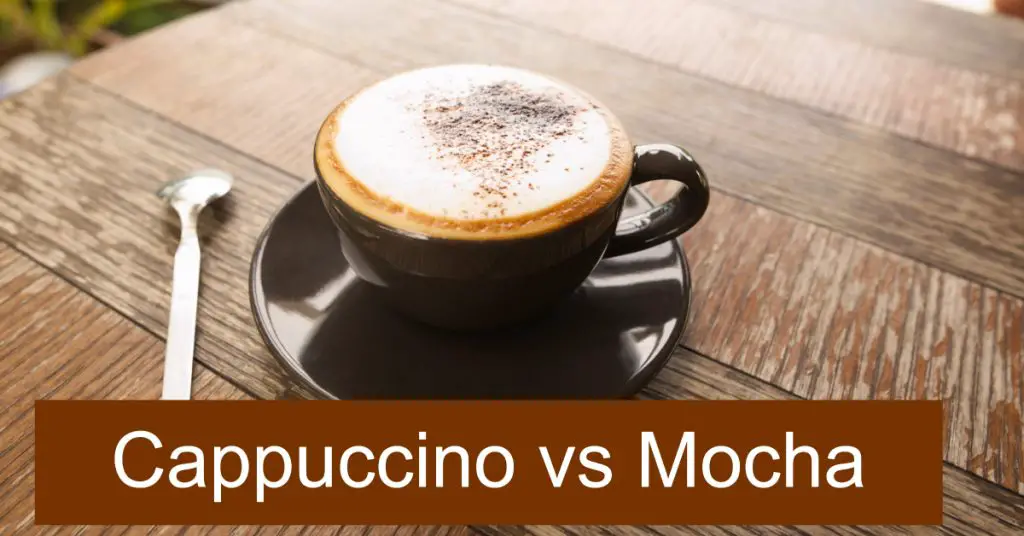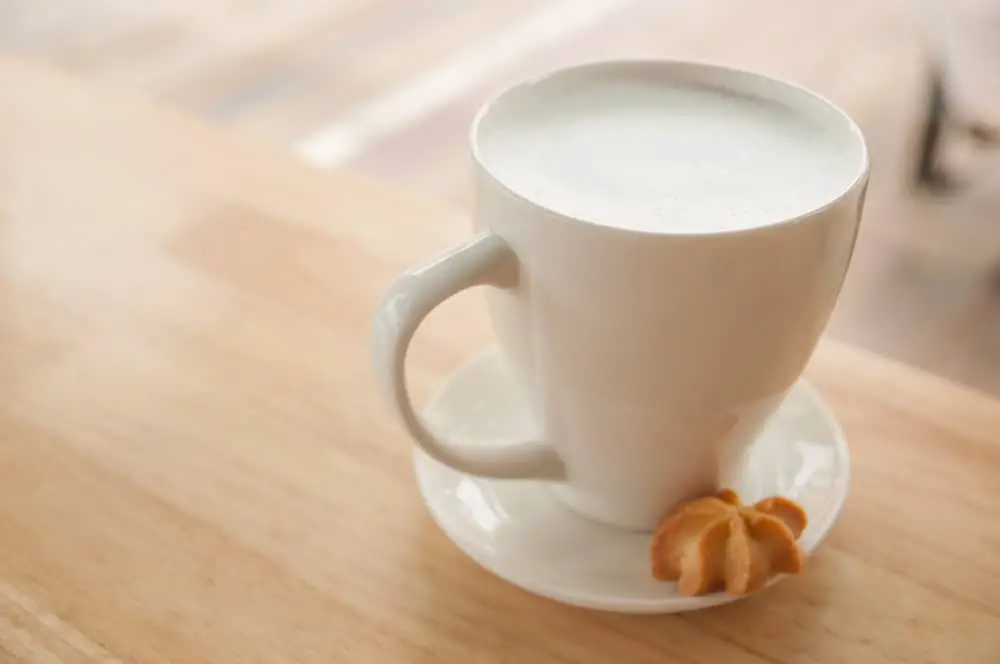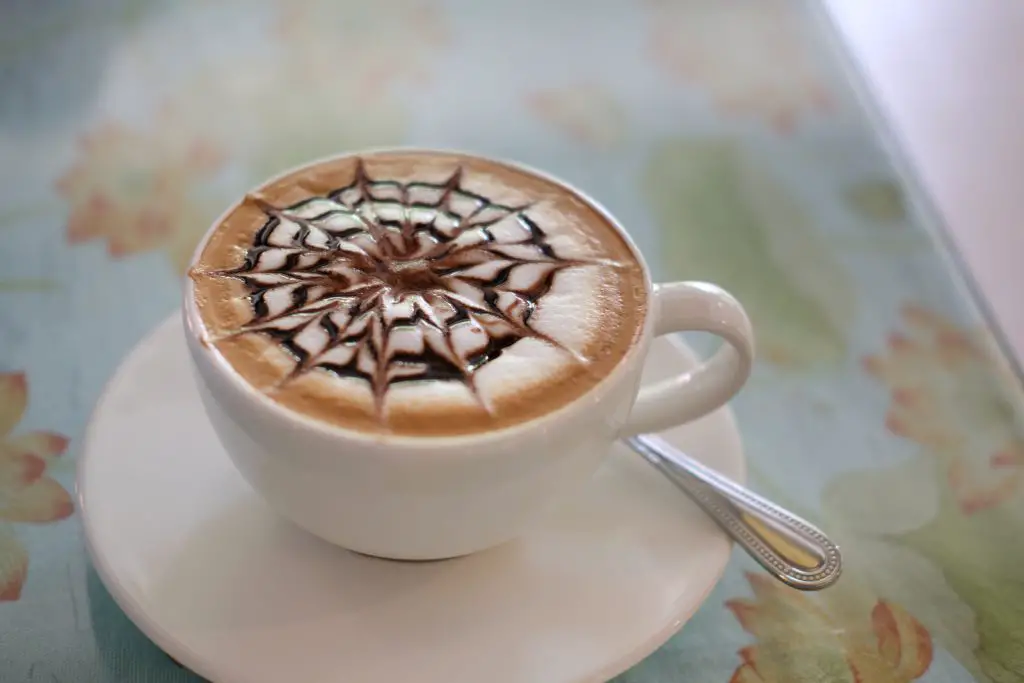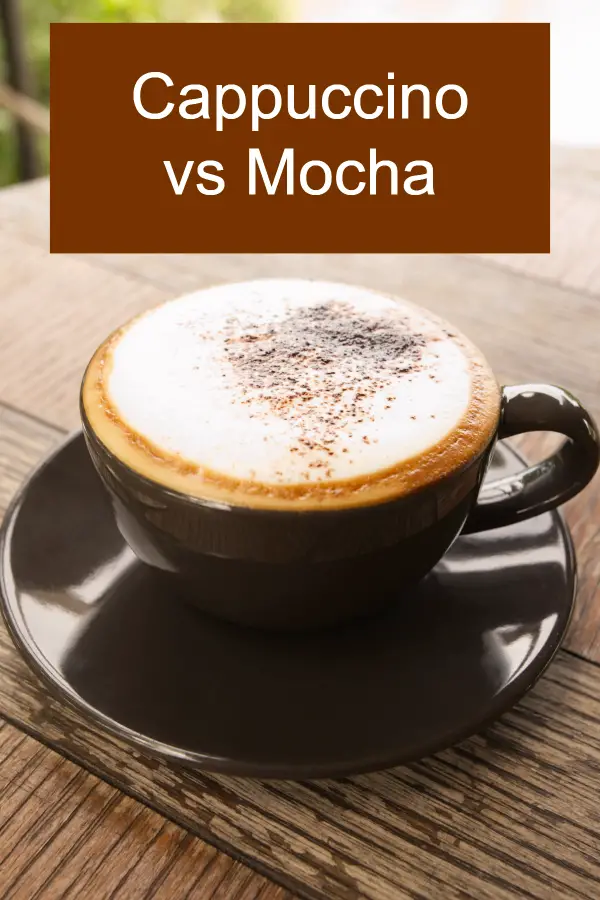Ahh, for serious coffee drinkers, the debate between cappuccino vs mocha is never ending. Do you like your coffee with a shot of smooth creaminess or one that’s rich and chocolatey? What type of coffee is your true match? Don’t worry, that’s why we’re here! We don’t take sides when it comes to cappuccino vs mocha – we just want you to be informed so you can make the beverage decision that’s right for you. So, pull up a chair, grab your mug, and let’s get caffeinated as we break down everything you need to know about cappuccino and mocha – two of the most popular coffees out there. Ready to take the plunge? Let’s go!

Quick Review
A cappuccino is an espresso-based coffee beverage made with steamed milk foam, while a mocha is espresso mixed with chocolate syrup or powder and topped with steamed milk. Both drinks may also be topped with whipped cream for extra indulgence.
Cappuccino vs Mocha: Origins
The distinct differences between cappuccino and mocha can be found in the origin of the two drinks. While both coffees are based on espresso beverages, the variations of each are quite distinct. Cappuccino, which is Italian for “little cap”, originated in Italy in the early 1900s when an inventor combined steamed milk with framed espresso shots to create a creamy and delicious beverage. On the contrary, mocha is believed to have been introduced in Yemen in the 15th Century with camel milk being used as a key ingredient instead of cow milk as it still is today. Mocha was also mixed with chocolate and spices including cardamom and/or saffron to give it its unique flavor.
Over the centuries, cappuccino has become more closely associated with breakfast while mocha is often consumed as a pick-me-up throughout the day or even after dinner. Cappuccino has become an international coffee favorite while mocha has taken off more slowly outside Yemen but continues to be popular all over the Middle East.
The debate between cappuccino vs mocha continues due to the distinct differences between them – from their origin to flavor profiles. Knowing where each comes from can help you make the best choice for your taste preferences. Now, let’s take a look at the origins of cappuccino, starting with its European roots.
Origin of Cappuccino
Cappuccino has a long, storied history that traces its roots all the way back to 16th century Italy. It began with a strong espresso topped with foamed milk or cream, and was favored by Italian royalty as a rich, indulgent beverage. Cappuccino caught on quickly in Europe, and soon in caffeine-crazed America as well.
Though there is historical evidence of brewed coffee drinks similar to cappuccino existing centuries prior, some debate exists over whether cappuccino specifically dates back to the 1600s due to the origin of the “capuchin monks” referenced by some sources in relation to the drink’s history. Named after the friars’ distinctive brown hooded robes (the cappuccio), the name may have been used to describe what resembles a layer of foam reminiscent of those robes atop a cup of coffee.
Regardless of its precise origins, cappuccino has become a favorite amongst coffee fanatics around the globe. With its unique flavor and creamy texture combining espresso and steamed milk, it continues to reign as one of the world’s most beloved coffee beverages.
In the next section we will explore mocha’s place within coffee culture and trace its own special historical journey.

Origin of Mocha
Mocha’s origin begins in Yemen, where the Mocha coffee bean was discovered. It was highly praised for its unique and naturally sweet flavor, and was the first source of coffee that went beyond local consumption. To this day, Yemen continues to be the sole producer of authentic Mocha Bean Coffee, grown in a small area on the southern coast of the country near Al-Makha.
The beans differ from other Arabica varieties due to their low acidity, as well as a distinct yet bold flavors of cocoa and spices. Originally, they were solely exported to other nations via boat and were marketed with their own specific blend due to their milder taste compared to other espresso varieties.
Today, Mocha is often confused with cappuccino. This is mostly because all blends sold as ‘mocha’ are made using an equal proportion of finely ground mocha bean along with espresso-style beans that produce a heavier, more robust cup of coffee more traditionally associated with cappuccino than mocha. However, it should be noted that both still reveal their own unique flavors depending on how it is brewed.
This leads us into the next section which will focus on brewing techniques used to create both cappuccinos and mochas.
Brewing Techniques
Brewing techniques can play an integral role in deciding which coffee is right for you. For cappuccino, the hallmark of this Italian style drink is the fluffy foam that is produced by steaming and texturing milk. The foam should be thick and creamy, with microfoam bubbles barely visible to the naked eye – this requires a professional espresso maker, as well as skilled technicians who understand the intricacies of tamping, pulling shots, and steaming. On the other hand, mocha is most commonly brewed using a drip brewing system or a French press. Both of these methods allow grinding just enough beans to make one good cup of coffee, while preserving freshness. For those looking to enjoy the unique and intense flavors of mocha without too much hassle, a simple long black (espresso with hot water) might be the way to go.
No matter which method you use, it is important to keep in mind that quality ingredients are paramount for superior flavor and enjoyment. In the next section, we will explore ingredients used when preparing cappuccino and mocha drinks, and how they impact your cup of joe.
Must-Know Points
Different brewing techniques can be used to produce cappuccino or mocha coffee drinks. Cappuccino typically involves steaming and texturing milk with a professional espresso maker, while mocha is usually made through a drip brewing system or French press. Quality ingredients are essential for the best flavor.
Ingredients
When it comes to coffee drinks, ingredients can make all the difference. Cappuccino and mocha are made with different ingredients, which can affect both the flavour and nutritional value of the beverage. Many people find themselves debating which one is better for them to consume.
A cappuccino typically consists of espresso shots, steamed milk and foamed milk, while a mocha contains espresso, steamed milk, chocolate syrup or powder and (sometimes) whipped cream. Both include caffeine from the espresso shots, although a mocha may contain more if extra chocolate syrup or powder is used.
Cappuccinos tend to be less sweet than mochas because they don’t usually include as much added sugar. This makes them a good choice for those who are watching their sugar intake. Mochas on the other hand, offer that delicious combination of coffee and chocolate flavours – but depending on what type of chocolate is used they might have quite a bit of added sugar in them.
So when it comes to ingredients, there are pros and cons to each beverage – it really just depends on your personal preferences and dietary needs. In terms of nutritional value and health benefits, however, a cappuccino might be the best option for those looking for fewer calories and less sugar.
Now that we’ve explored the general differences between cappuccino and mocha’s ingredients let’s take an even closer look at what goes into a cappuccino. In the next section we’ll discuss the specific ingredients of cappuccino in greater detail.
Ingredients of Cappuccino
When it comes to ingredients, cappuccino and mocha may seem quite similar. However, there are some key differences that make each beverage unique. Cappuccino is traditionally composed of espresso, steamed milk, and a layer of foam. The exact ratio of ingredients will vary depending on individual preferences, but the classic version is around one-third espresso, one-third steamed milk, and one-third foam. Additionally, this base recipe can be customized with different flavors or toppings like cinnamon or cocoa powder, to create a unique experience.
On the other hand, mocha contains both espresso and steamed milk like a cappuccino, but also features chocolate syrup or powder as an added ingredient. This gives the drink an extra fudgy flavor that stands out from other coffee drinks. The chocolate in mocha also makes for a thicker, creamy texture that’s slightly smoother than cappuccino. Finally, unlike cappuccinos which can be further adjusted with flavors or toppings, mocha tends to stay as it is—sweetened with chocolate alone.
Both options offer a delicious experience for coffee lovers everywhere; however, it’s important to remember that both drinks contain caffeine, with mocha containing slightly more due to the added flavoring. With this in mind, the next step is to examine the ingredients in a mocha and determine what makes this coffee variety so distinctive.
With the understanding of what goes into a cappuccino developed, we now transition to discussing the ingredients that make up a mocha.
- A cappuccino consists of espresso topped with steamed milk, often with a layer of froth on top. A mocha also has espresso, but it also includes hot chocolate or cocoa powder in the beverage.
- An 8-ounce cup of cappuccino made with whole milk will have approximately 87 calories and 5.4 grams of fat; an 8-ounce cup of mocha made with whole milk will have approximately 116 calories and 5.6 grams of fat.
- A cup of cappuccino contains slightly more caffeine than a cup of mocha, with an 8oz. cup containing around 85mg of caffeine compared to an 8oz. mocha which contains around 65mg.
Ingredients of Mocha
Mocha is a popular coffee-based beverage that blends espresso and hot steamed milk with a chocolate flavor. Depending on the recipe, mochas may also contain ingredients such as cocoa powder, dark chocolate, white chocolate, caramel and more. Typically served in small cups, they are often topped off with foam or whipped cream to give them a creamy taste.
There is some debate over what makes up the perfect mocha recipe. While traditional recipes call for a combination of espresso and steamed milk with cocoa powder or syrup, some people argue that using real chocolate in place of the powdered version adds a richer taste. Additionally, some feel that adding flavoring syrups or sweeteners detracts from the overall flavor profile of the drink.
On one hand, using real chocolate gives mochas a richer flavor and smoother texture. On the other hand, using syrups can add sweetness and an extra layer of flavoring with various options such as peppermint or hazelnut for added variety to the coffee experience. Ultimately it comes down to personal preference when deciding which ingredients create the best mocha.
Now that we have explored the ingredients behind mochas, let’s move onto exploring their taste and caffeine levels in our next section.

Taste and Caffeine Levels
The debate between cappuccino and mocha has been ongoing for years, but one of the key differences between these two popular coffee concoctions is their taste and their levels of caffeine. Cappuccinos are traditionally made with espresso, steamed milk, and milk froth on top; this combination creates a subtle creamy flavor that is satisfying to most palates. On the other hand, mochas are made with a shot of espresso and chocolate syrup or powder, which can provide a sweeter, more intense flavor.
Caffeine-wise, cappuccinos have slightly less caffeine than mochas because espresso itself contains less caffeine by volume than milk. However, it’s important to note that depending on the proportion of milk to espresso used in your cappuccino or mocha, the amount of caffeine can vary greatly among different recipes. This means that an individual can still get their desired level of wakefulness in either beverage.
Given the range of flavors and possible caffeine levels they each offer, cappuccinos and mochas can be an excellent option for anyone looking to mix up their morning cup of joe. In the next section we will explore the differences in taste between cappuccino vs mocha, so let’s jump right into it!
Cappuccino vs Mocha in Taste
When it comes to Cappuccino vs Mocha in terms of taste, the debate can often become heated. Both coffee options offer a unique flavor to coffee lovers, but which one is better for you? Let’s take a look at what each drink has to offer.
The Cappuccino is known for its strong espresso base and foamed milk. It has a bold espresso taste that many enjoy – and with the addition of flavorful foamed milk, there’s no surprise why this coffee choice remains popular amongst consumers. On the other hand, the Mocha offers a sweeter alternative that incorporates chocolate syrup or powder alongside espresso and steamed milk. This provides a smooth, silky taste that can be quite enjoyable depending on your preference.
At the end of the day, it is up to you to decide which drink best suits your individual taste preferences. If you prefer a richer and bolder flavor, then try out a cappuccino. However, if you are looking for something slightly sweet, then go for the Mocha instead!
In terms of caffeine levels in each drink, we’ll explore that in more depth in the following section.
Caffeine Levels in Cappuccino vs Mocha
Caffeine levels in coffee drinks vary depending on the type of liquid and solids used as ingredients. Cappuccino traditionally contains shots of espresso, steamed milk and a layer of foam. Mocha is made with espresso, chocolate syrup, steamed milk and whipped cream. Both drinks provide an energizing boost to help kickstart your day.
When looking at the caffeine levels in Cappuccino vs Mocha, it is important to remember that caffeine levels can vary depending on the size of the beverage and strength of the coffee beans used. A standard 8-ounce cup of cappuccino contains around 80mg of caffeine, while a traditional mocha will contain around 125mg of caffeine. However, some specialty coffee houses may make their mochas stronger than their cappuccinos by adding double or triple shot espressos to the mix.
At the end of the day, it really all comes down to personal choice and preference. When faced with the decision of Cappuccino vs Mocha, considering both taste and energy levels are key factors for each customer’s unique needs. For those looking for an energetic kick without a lot of sugar or calories, then cappuccino is likely going to be the right choice. On the other hand, if you’re looking for something sweet and less intensely caffeinated then mocha might be your go-to option.
Now that we’ve taken a closer look at caffeine levels in Cappuccino vs Mocha, our next section dives into detail by examining a comprehensive comparison chart.
Comparison Chart
When it comes to Cappuccino vs Mocha, there are certain characteristics that make them different from one another, and whether or not one is better than the other ultimately depends on personal preference. The following chart compares key attributes for both coffees:
| Cappuccino | Mocha | |
| Caffeine Levels | Low | High |
| Flavor | Creamy | Chocolatey |
| Sweetness | Low | High |
| Milk | Steamed | Powdered |
Cappuccino typically has low caffeine levels, so it’s a good coffee option for those who aren’t looking for a big energy boost. Its flavor is creamy and mild, and sweetness is also quite low due to lack of sugar added in. Cappuccinos are also typically made with steamed milk as opposed to powdered milk.
Mocha coffees, on the other hand, have relatively high caffeine levels which can give drinkers a nice jolt of energy. Mochas usually have a more prominent chocolatey flavor and are sweeter than cappuccinos due to the addition of chocolate syrup. They are topped with powdered milk, though some coffee shops may offer the option of steamed milk.
In short, cappuccino is a milder coffee choice, while mocha offers more intense flavors and higher caffeine content. Depending on individual preferences and needs, either one could be the right choice!
Frequently Asked Questions
How do cappuccino and mocha compare in terms of caffeine content?
Cappuccino and mocha both contain caffeine, but the amount of caffeine in each differs. Cappuccinos typically have between 75 to 150 mg of caffeine per serving, while mochas generally have more at around 100 to 225 mg of caffeine per serving. This difference can be attributed to the fact that mochas often contain additional ingredients such as chocolate syrup or powder, whereas cappuccinos are just espresso with steamed milk. So those who are looking for a strong caffeine boost should reach for the mocha while those who want something milder can stick to the cappuccino.
What distinguishing flavor notes do each of the drinks bring to the palate?
Cappuccino has a milder, sweeter taste that is typically made with espresso, milk and steamed milk foam. Common flavor notes associated with it are caramel, chocolate, and hazelnut. In comparison, mocha has an intense and richer taste due to the addition of chocolate syrup or powder. Its flavor notes include cocoa, caramel, vanilla, and nutty undertones.
The key difference comes down to cocoa and chocolate. Cappuccino doesn’t have cocoa in it which gives it a more subtle flavour than mocha. Mocha however includes the added cocoa flavour giving it a richer more decadent taste which is delicious for those looking for a more indulgent coffee experience.
What is the difference in the ingredients used to make cappuccino and mocha?
The primary difference in the ingredients used to make cappuccino and mocha is that cappuccino typically contains espresso topped with steamed milk and foam, while mocha contains a mixture of espresso, steamed milk, and chocolate syrup.
Cappuccinos are usually made with either one or two shots of espresso, depending on personal preference. When a café prepares a cappuccino, they add steamed, frothed milk atop the coffee — hence the signature layer of white foam. Some drinkers may choose to add sugar or a flavored syrup to sweeten their latte.
On the other hand, a mocha can contain much more ingredients than its counterpart. A traditional mocha is espresso blended with an equal part of steamed milk and some chocolate syrup or powder. This combination creates a sweet frappe-like beverage unlike the bitter taste of cappuccino. Unlike cappuccino, a mocha can also be topped off with whipped cream adding an extra layer of sweet creaminess on top.
Ultimately which coffee is right for you depends on what you’re looking for in terms of flavor and texture. Cappuccino enthusiasts enjoy that classic bitterness from the espresso beans complemented by thick and creamy foam. Mocha lovers instead seek out smooth sweetness from their drink thanks to the addition of chocolate syrup.

